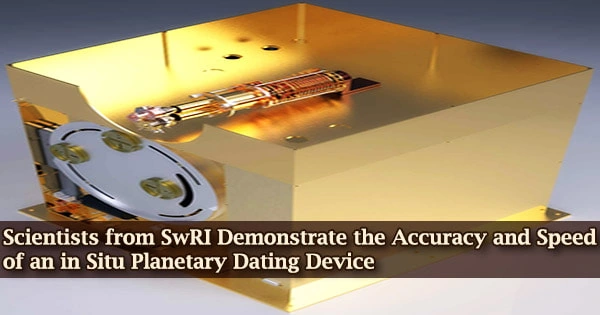Scientists at the Southwest Research Institute have improved the speed and accuracy of a laboratory-scale apparatus that may be used to determine the age of planetary objects on-site. The Chemistry, Organics, and Dating Experiment (CODEX) instrument is being miniaturized by the team in order to make it viable for spaceflight and lander missions.
“In situ aging is an important scientific goal identified by the National Research Council’s Decadal Survey for Mars and the Moon as well as the Lunar and Mars Exploration Program Analysis Groups, entities responsible for providing the science input needed to plan and prioritize exploration activities,” said SwRI Staff Scientist Dr. F. Scott Anderson, who is leading CODEX development. “Doing this onsite rather than trying to return samples back to Earth for evaluation can resolve major dilemmas in planetary science, offers tremendous cost savings and enhances the opportunities for eventual sample return.”
CODEX will be about the size of a microwave and will have seven lasers as well as a mass spectrometer. In situ measurements will help answer fundamental questions about the history of the solar system, such as when Mars was potentially habitable. CODEX has a precision of ±20-80 million years, which is much better than the current Mars dating methods, which have a precision of ±350 million years.
“CODEX uses an ablation laser to vaporize a series of tiny bits off of rock samples, such as those on the surface of the Moon or Mars,” said Anderson, who is the lead author of a CODEX paper published in 2020.
“We recognize some elements directly from that vapor plume, so we know what a rock is made of. Then the other CODEX lasers selectively pick out and quantify the abundance of trace amounts of radioactive rubidium (Rb) and strontium (Sr). An isotope of Rb decays into Sr over known amounts of time, so by measuring both Rb and Sr, we can determine how much time has passed since the rock formed.”
The idea behind crater dating is simple; the more craters, the older the surface. It’s a little like saying that a person gets wetter the longer they have been standing out in the rain. It’s undoubtedly true. But as with the falling rain, we don’t really know the rate at which meteorites have fallen from the sky. That’s why radioisotope dating is so important. Radioactive decay is a clock that ticks at a known rate. These techniques accurately determine the ages of rocks and minerals, allowing scientists to date events such as crystallization, metamorphism, and impacts.
Dr. Jonathan Levine
While radioactivity is a common method for dating samples on Earth, it has only been used in a few other parts of the solar system. Rather, astronomers have relied on counting impact craters on planetary surfaces to constrain the inner solar system’s chronology.
“The idea behind crater dating is simple; the more craters, the older the surface,” says Dr. Jonathan Levine, a physicist at Colgate University, who is part of the SwRI-led team.
“It’s a little like saying that a person gets wetter the longer they have been standing out in the rain. It’s undoubtedly true. But as with the falling rain, we don’t really know the rate at which meteorites have fallen from the sky. That’s why radioisotope dating is so important. Radioactive decay is a clock that ticks at a known rate. These techniques accurately determine the ages of rocks and minerals, allowing scientists to date events such as crystallization, metamorphism, and impacts.”
CODEX’s most recent version is five times more sensitive than its predecessor. To increase data quality, the sample’s distance from the sensor was considerably changed to achieve this precision. To better limit the chronology of events in solar system history, the instrument contains an ultrafast pulsed laser and improved signal-to-noise ratios.
“We are miniaturizing the CODEX components for field use on a lander mission to the Moon or Mars,” Anderson said. “Developing compact lasers with pulse energies comparable with what we currently require is a considerable challenge, though five out of the seven have been successfully miniaturized. These lasers have a repetition rate of 10 kHz, which will allow the instrument to acquire data 500 times faster than the current engineering design.”
The CODEX mass spectrometer, power supplies, and timing circuits are all compact enough to go onto a spacecraft. To withstand launch and extended autonomous operations in foreign surroundings, instrument components are being improved to improve ruggedness, thermal stability, radiation resistance, and power efficiency.
SwRI is developing two versions of the instrument for future missions: CODEX, which is built for Mars and can measure organics, and CDEX, which is designed for the Moon and does not require organic measurements.
The instrument is being developed with funding from NASA’s Planetary Instrument Concepts for the Advancement of Solar System Observations (PICASSO) and Maturation of Instruments for Solar System Exploration (MatISSE) programs, with previous support for CODEX/CDEX coming from the Planetary Instrument Definition and Development Program (PIDDP).





